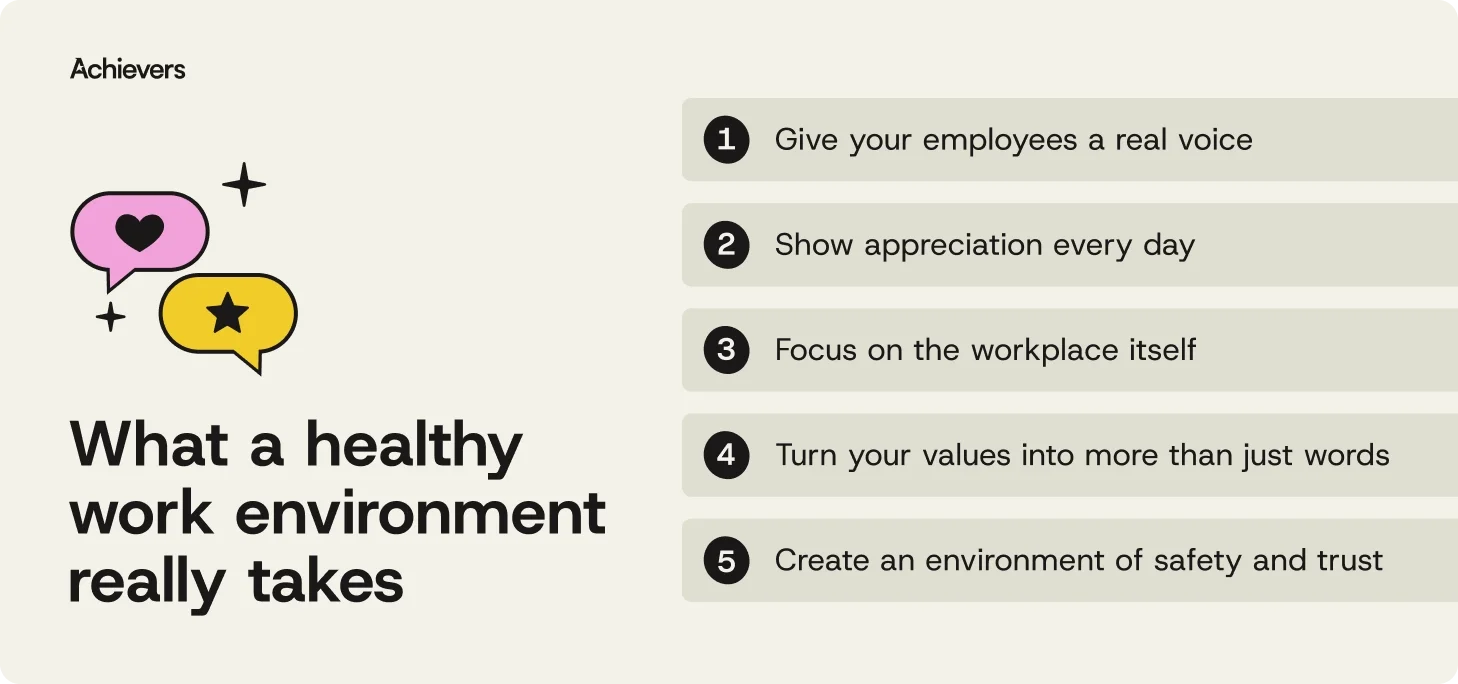Table of contents
What makes a workplace thrive? It’s not just the snacks in the breakroom or a killer view from the 27th floor. While perks and pay matter, they’re not the whole story. A truly great company culture puts people first — by creating a healthy environment where employees feel seen, supported, and empowered to do their best work.
That sounds nice in theory. But in practice? It takes more than good intentions and the occasional pizza party. Building a healthy work environment — especially across hybrid and remote teams — requires clarity, consistency, and a culture rooted in trust.
This guide lays out 15 practical ways to get there. No jargon. No fluff. Just real ideas to help your people feel appreciated and your business run better. Let’s dive in.
15 ways to build a healthy work environment
Building a healthy work environment isn’t about quick fixes or trendy perks — it’s about creating the conditions where people can do their best work and actually enjoy doing it. That takes intention, consistency, and a culture that puts people first. The good news? Small actions add up fast.
Here are 15 practical ways to strengthen your organizational culture — from boosting trust and recognition to making sure your team has what they need to thrive.

1. Give your employees a real voice
Asking for employee feedback is easy. Acting on it? That’s where the magic — well, science — happens. When people feel heard, they’re more engaged and more likely to stick around. Move beyond annual surveys and create space for frequent, meaningful conversations. Tools like pulse surveys and HR chatbots can help. Just remember: collecting input without follow-through can backfire. Encourage managers to co-create action plans with their teams. After all, feedback is only useful if it leads to something better.
2. Show appreciation every day
Recognition doesn’t need to be grand — just real, specific, and consistent. A timely “thank you” can turn a tough day around, and organizations that recognize often see higher engagement and retention. In fact, employees who feel appreciated are 55% more likely to experience belonging at work. Make it a habit by encouraging everyone — not just managers — to celebrate wins publicly. And if you’re still relying on twice-a-year performance reviews, recognition tech can help you show appreciation in real time — no confetti cannon required.
3. Focus on the workplace itself — even if you’re remote
A healthy work environment isn’t just about culture — it’s also about the physical (or virtual) space. Whether your team’s in-office, remote, or hybrid, comfort matters. That means ergonomic chairs, decent lighting, and maybe a plant or two. Offer stipends to upgrade home setups and check in regularly about what employees need to stay productive. Even something as simple as a clutter-free desk or extra monitor can go a long way. Work may not always be fun — but working in a space that works for you helps.
4. Turn your values into more than just words
Empty values are just wall art. But values that are lived — modeled by leaders and reinforced every day — help build trust, attract talent, and boost performance. In fact, companies with cultural alignment and innovation strategies see stronger profits and growth. Make sure your values are clear, memorable, and reflected in how people are recognized. Employees notice when leadership walks the talk — and they’ll follow suit. Because no one wants to work somewhere that preaches “integrity” and practices “do as I say, not as I do.”
5. Create an environment of psychological safety and trust
Psychological safety means employees can speak up without fear of being shut down or side-eyed. It’s not just about being “nice” — it’s about trust, empathy, and a shared sense of safety. When that’s in place, employees are more engaged, motivated, and loyal. Encourage managers to lead with empathy, ditch micromanagement, and check in often. Workshops can help build these skills — and they send a message that creating a supportive environment is everyone’s job. After all, trust isn’t a perk — it’s a necessity.
6. Prioritize cultural alignment when hiring
Culture isn’t just what’s written in your handbook — it’s how people behave when no one’s watching (and especially when they are). That’s why hiring for cultural fit matters. Ask candidates about the environments they’ve thrived in, what values drive them, and how they align with your mission. And remember, this goes both ways. Candidates are picking up on your culture too — so make sure your interview process reflects the values you claim to champion. If you talk teamwork but your team ghosted the meeting, candidates will notice.
7. Empower your team with what they need to succeed
Empowerment doesn’t mean tossing someone into the deep end and hoping for the best. It means giving employees the tools, trust, and support to thrive. That could look like training, autonomy, flexibility — or all three. HR, managers, and leadership need to work together to remove roadblocks and create room for growth. When people feel supported, they show up differently — more confident, more capable, more engaged. So yes, empowerment takes effort — but so does backfilling a role because someone didn’t feel set up for success.
8. Foster an environment of open communication
Poor communication is like a slow leak in your culture — eventually, it causes serious damage. Employees left in the dark tend to disengage, stress rises, and collaboration takes a nosedive. The fix? Create a culture of openness, starting from the top. Leaders should share honestly, invite feedback, and model active listening. Communication shouldn’t feel like a privilege — it should be part of the everyday workflow. When people feel safe to speak up and stay informed, they bring their best ideas (and selves) to the table.
9. Make opportunities for growth
Career stagnation is a retention killer — just ask the 65% of employees who leave jobs because they can’t grow. Building a healthy workplace means investing in your people’s development, not just their output. That means mentorship, skills training, clear paths to advancement — and a culture that actually supports taking those steps. Growth isn’t one-size-fits-all, and it doesn’t always mean a promotion. But when employees feel like they’re moving forward, they’re far more likely to stay. Because nobody wants to feel like they’re stuck in professional quicksand.
10. Adopt a flexible mindset
Flexibility isn’t a fad — it’s a business advantage. Remote and hybrid employees are 60% more likely to go the extra mile, and it’s not hard to see why. When people can balance life and work on their own terms, stress drops and performance rises. Offering flexible hours, work-from-anywhere options, or asynchronous collaboration builds trust and boosts morale. It also helps you attract diverse talent and fresh thinking. Flexibility isn’t about giving up control — it’s about creating space where people can do their best work, their way.
11. Promote collaboration
Collaboration isn’t just about teamwork — it’s about building trust, breaking silos, and getting better results (plus fewer “this could’ve been an email” moments). When employees work toward shared goals, they communicate more openly, innovate faster, and feel more connected. That sense of belonging matters — employees who collaborate regularly are 17% more satisfied at work. Make it easy for teams to connect across departments, share ideas, and give feedback freely. Because when people feel like they’re part of something bigger, they show up ready to make it better.
12. Promote inclusivity
Inclusivity isn’t just the right thing to do — it’s also a smart business strategy. Diverse teams make better decisions, bring more creativity, and keep your talent pool deep and dynamic. But real inclusion goes beyond metrics. It’s about creating a space where everyone feels valued, heard, and empowered to contribute. Build that culture by amplifying underrepresented voices, training leaders to lead inclusively, and making room for different perspectives at every level. When people feel like they truly belong — they bring their whole selves and their best work.
13. Reward your employees
When recognition is frequent and meaningful, employees go from “doing the job” to doing their best. And the data backs it up — employees recognized monthly are 36% more likely to be engaged and productive. Recognition isn’t fluff — it sets a standard, reinforces culture, and strengthens loyalty. Celebrate wins, both big and small, and make recognition everyone’s responsibility — not just HR’s. Bonus points if it’s timely, specific, and tied to company values. Bottom line: a little appreciation goes a long way — and it pays off.
14. Encourage stress management techniques
Stress is the unwanted coworker nobody asked for — but most employees are stuck working with it anyway. With 80% of workers reporting job-related stress, it’s time to take well-being seriously. That means going beyond lip service and offering real support: access to mental health resources, flexible schedules, or even a simple prompt to step away from the screen. Encourage mindfulness, movement, and boundaries. When people know it’s okay to take care of themselves, they’ll bring more focus, energy, and creativity to the work that matters.
15. Regularly organize team building activities
Team building isn’t just ropes courses and awkward icebreakers — it’s how you turn a group of colleagues into an actual team. Done right, it boosts morale, reinforces values, and strengthens connection. And yes, it can be fun too. Whether it’s a volunteer day, trivia night, or problem-solving challenge, choose activities that reflect your culture and bring people together. Studies show great team building can increase innovation tenfold — and that’s no small thing. Because when people trust each other, they work better — and stick around longer.
Start building a better work environment today
A healthy workplace isn’t just a nice-to-have — it’s a competitive edge. When employees feel heard, appreciated, and connected to a larger purpose, innovation rises, trust deepens, and performance follows. The best part? You don’t have to do it alone.
Achievers makes it easy to recognize great work and listen to what your people need — all in real time, from anywhere. With science-backed tools and seamless integrations, we help you shape the behaviors that build stronger cultures.
Because when people thrive at work, the whole business thrives with them.



